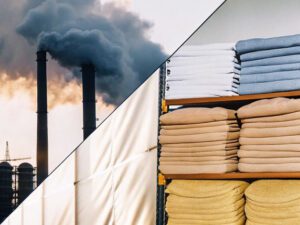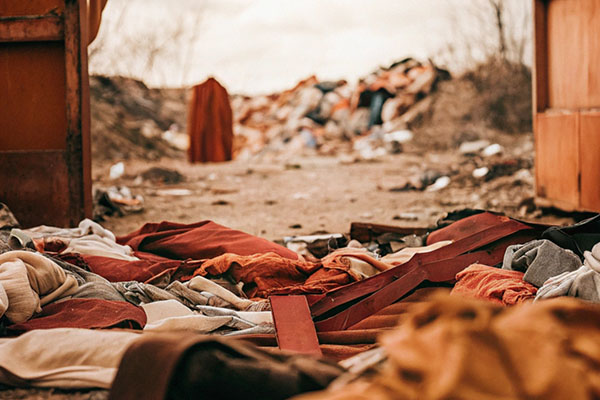Fashion is an essential part of our lives, but its environmental toll is staggering. From resource depletion to pollution, the industry’s impact on our planet is undeniable.
The environmental costs of apparel production include water pollution, global carbon emissions1, and textile waste. Sustainable practices and consumer awareness are key to addressing these issues.
Understanding these impacts is crucial if we want to wear clothes without costing the earth. Let’s explore this topic in depth.

What are 3 environmental impacts of fashion?
Fashion’s rapid growth has led to significant environmental consequences. The three primary impacts are water pollution, carbon emissions, and textile waste.
Fashion contributes to water contamination through dyeing processes, generates vast carbon emissions from manufacturing and transportation, and creates mountains of waste from discarded clothing.

How does water pollution occur in the fashion industry?
The dyeing and finishing processes for textiles use harsh chemicals that often end up in water bodies. Countries with lax regulations suffer the most. Rivers near textile hubs frequently turn the color of the season’s fashion trends.
| Statistic | Impact |
|---|---|
| 20% of global wastewater | Comes from textile dyeing and finishing. |
| 72 toxic chemicals | Identified in textile dyeing wastewater. |
Effluent treatment plants can mitigate this, but they are expensive and underused in developing nations.
What role do carbon emissions play in apparel production?
The fashion industry accounts for roughly 10% of global carbon emissions1. Manufacturing synthetic fibers like polyester involves energy-intensive processes. Additionally, transporting goods worldwide adds to emissions.
A T-shirt made in Asia and shipped to North America might travel over 10,000 miles, leaving a significant carbon footprint.
Why is textile waste a growing concern?
Fast fashion encourages frequent purchases, leading to higher discard rates. Around 92 million tons of textile waste is generated globally each year. Much of this ends up in landfills or incinerators.
| Disposal Method | Percentage |
|---|---|
| Landfill | 73% of textile waste |
| Recycling | Less than 15% |
Without better recycling systems, this waste will only increase.
How do synthetic fabrics harm the environment?
Synthetic fabrics like polyester and nylon are petroleum-based. While durable and affordable, they come with hidden costs for the planet.
Synthetic fabrics contribute to microplastic pollution2 in oceans and require non-renewable resources for production. They also take hundreds of years to decompose.
What are microplastics, and why are they dangerous?
When synthetic fabrics are washed, they shed tiny fibers called microplastics. These fibers enter waterways and are ingested by marine life. Scientists estimate that 35% of microplastics in the ocean come from synthetic textiles.

How does the production process of synthetics compare to natural fibers?
Synthetic fibers consume less water than cotton but are far less sustainable due to their reliance on fossil fuels. For example:
| Fiber Type | Water Usage | Energy Usage | Biodegradability |
|---|---|---|---|
| Cotton | High | Moderate | Biodegradable |
| Polyester | Low | High | Non-biodegradable |
This trade-off challenges efforts to balance environmental priorities.
What steps can brands take to reduce their environmental impact?
Sustainable fashion is gaining momentum as brands and consumers recognize the need for change. Companies can make significant improvements by adopting eco-friendly practices.
Brands can reduce environmental impact by using sustainable materials, improving production efficiency, and promoting circular fashion3 through recycling programs.
What are some examples of sustainable materials?
Materials like organic cotton4, Tencel, and recycled polyester are more environmentally friendly. For example, Tencel is made from wood pulp and uses a closed-loop process that recycles water and chemicals.
| Sustainable Material | Benefits |
|---|---|
| Organic Cotton | Grown without harmful chemicals. |
| Tencel | Requires less water and energy. |
| Recycled Polyester | Reduces reliance on virgin petroleum. |
How does circular fashion help?
Circular fashion3 focuses on designing clothes that can be reused or recycled. Brands like Patagonia and H&M have introduced take-back programs to collect and recycle old garments, reducing textile waste.
How can consumers reduce the environmental costs of their clothing choices?
Consumers play a crucial role in transforming the industry. Mindful purchasing and care for garments can make a big difference.
Consumers can reduce their impact by buying quality over quantity, choosing second-hand items, and properly caring for their clothes to extend their lifespan.

Why is buying less but better important?
Fast fashion5 promotes frequent shopping, but high-quality, durable clothing lasts longer. Opting for timeless styles over trends reduces waste and supports sustainability.
How does proper garment care reduce environmental impact?
Washing clothes less often, using cold water, and air-drying can save energy and reduce microplastic shedding. Simple steps like mending clothes instead of discarding them also help.
| Action | Environmental Benefit |
|---|---|
| Wash in Cold Water | Saves energy. |
| Air Dry Clothes | Reduces carbon emissions. |
| Repair Instead of Discard | Cuts down textile waste. |
Conclusion
The environmental costs of apparel production are vast, but solutions exist. From adopting sustainable practices to making conscious consumer choices, we can reduce fashion’s impact on our planet. Each small step brings us closer to a cleaner, more sustainable future.
-
Visit this link to understand microplastics from textiles better. ↩ ↩
-
Check this source for verified carbon emission statistics now. ↩
-
Access this link to learn about fast fashion’s effects today. ↩ ↩
-
Use this resource to discover circular fashion principles easily. ↩
-
Explore this source for organic cotton’s reduced chemical usage. ↩













